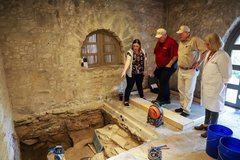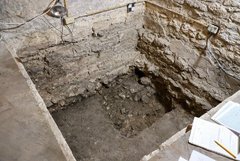Recently, Alamo Archaeologist Kristi Nichols gave President of the Alamo Society, Brian Gibson, a tour of the ongoing archaeological investigations happening in the Long Barrack. Jack Edmondson, a member of the Alamo Society and author of Alamo Story: From Early History to Current Conflicts, accompanied Mr. Gibson for this inside look into the history beneath the oldest building in Texas.
Both Gibson and Edmondson were impressed by how meticulous, and detailed the investigation process is.




